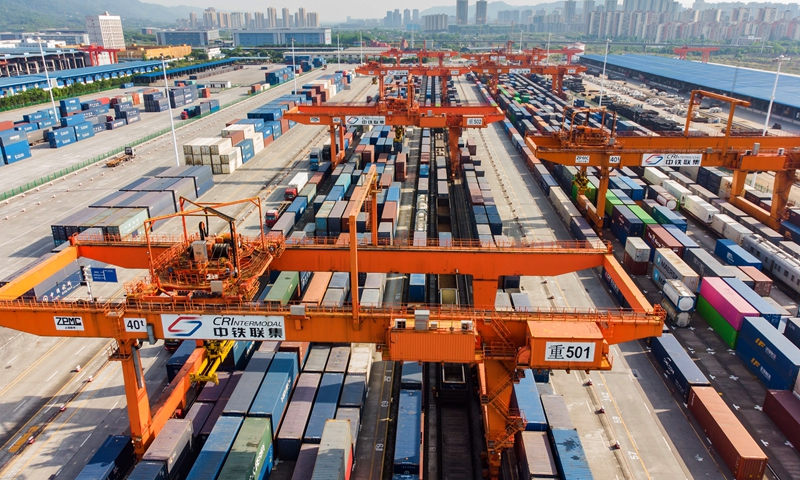China's new intl land-sea corridor expands trade with ASEAN, with goods transported up 30% in H1 2022

Photo taken on April 22, 2022 shows the Chongqing International Logistics Park in Southwest China's Chongqing Municipality. Chongqing is a key node on the New Land-Sea Corridor, a passage between western Chinese provincial regions and Southeast Asia. Photo: VCG
The New International Land-Sea Trade Corridor saw goods transported jump 30 percent year-on-year in the first half of the year, as the passage has become an important channel linking China with the Association of Southeast Asian Nations (ASEAN).
Experts said on Monday that the corridor will play a larger role in strengthening trade cooperation, suggesting jointly building industrial parks and strengthening data sharing to drive regional economic upgrading.
The corridor transported 216,000 standard containers of goods in the first half of 2022, up 30.3 percent year-on-year, according to data released at the 4th Western China International Fair for Investment and Trade, which closed in Southwest China's Chongqing city on Sunday.
The corridor was jointly built by provincial-level regions in western China and ASEAN members, with Chongqing serving as its operations center and goods sent via various transport means including rail, road and water. Currently, the passage has expanded to linking with 319 ports in 107 countries and regions.
According to a report released by the Ministry of Commerce at the fair, Chinese provinces and municipalities along the corridor saw their import and export volume with Southeast Asian countries continuously grow over the past five years, from $58.9 billion in 2017 to $107.7 billion in 2021, and the categories of items transported expanded to over 640 from around 50.
"The transport mode combining railway and sea shipment is convenient in that it saves travel time and costs, and attracts customers from countries and regions along the route. As far as I know, Vietnam actively contacted Chongqing in joining the corridor," Xu Liping, a research fellow on Southeast Asian studies at the Chinese Academy of Social Sciences in Beijing, told the Global Times on Monday.
By giving play to the comparative advantages of economies, the New International Land-Sea Trade Corridor now serves as a new momentum for the joint development of the [China-proposed] Belt and Road Initiative (BRI), Xu said.
Along with the opening of routes such as the China-Laos Railway as well as rail links connecting Thailand, Laos, China and Mongolia, trade between China and ASEAN continues to grow, reaching $458.55 billion in the first half of 2022, up 11.5 percent year-on-year, data from Chinese customs showed.
As of July 3, the China-Laos Railway had carried 4.11 million passengers and transported 5.03 million tons of cargo, according to data sent to the Global Times by state railway operator China State Railway Group Co.
Cross-border shipments of cargo hit 840,000 tons.
By exploring new business models such as "gate to gate" and intermodal logistics, cold-chain logistics are taking Southwest China's Yunnan Province's vegetables and fresh flowers south to Laos and Thailand, met with northbound Southeast Asian specialties including durian and mangosteen from Thailand and Vietnam.
In order to promote the high-quality development of the corridor, Xu suggested smoothing the industry and supply chains between China and ASEAN, while jointly building industrial parks and economic cooperation zones along the corridor.
China has been exploring more cooperation opportunities with trade partners along the passage. The country is building an integrated banana supply chain with Cambodia by depending on the corridor, while it is also working with Malaysia on a supply chain resource center along the corridor, the Xinhua News Agency reported.
In June, the Chinese Ministry of Transport said that it will set up a special office to oversee the operation, stressing plans to expand the transport capacity of the trade corridor and promote key projects such as railways, highways, ports and civil aviation, according to a statement on the ministry's website.
Global Times



